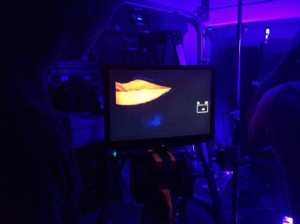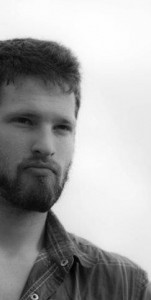Music + Video: The Vibrant Visual Translation of Erica Glyn’s “In Silence”
With YouTube still serving as a primary source of sonic discovery for everyone from fans to music supervisors, crafting a standout music video remains a top priority – for artist, producers, and labels alike.
Not all of them need be high concept – as the scores of recently uploaded “Harlem Shake” productions attest – but when a music video goes deep, things get interesting.
Many a SonicScoop visitor is already familiar with the Brooklyn artist Erica Glyn, who interviewed super-mixer Chris Lord-Alge in our popular “Power Sessions” series. But there’s another way to experience Glyn on video, and that’s in her own set of creative videos she’s shooting to accompany the singles off her entrancing album Static.
How does a song inspire the video’s director? Glyn’s last video, “In Silence,” is a perfect vehicle for posing that question, and exploring the interplay between the aural creator and their visual counterpart. Treat yourself to a viewing of “In Silence” below, and then read how Glyn and Austin-based director Seth Blaustein fed off each other for this memorable mind-bender – the dreamlike imagery is an intensive match for the haunting natural/synthetic trip hop it accompanies.
And if you like what you see, keep your eyes peeled! Glyn’s next collaboration with Blaustein, the Static single “Animal” debuts next week – and we’re sure you’ll take extra special notice of that one as well.
Erica Glyn:
Producing “In Silence”
With no intention of actually including this song on the album Static, I allowed myself to “go to town” with “In Silence,” so to speak.
I thoroughly enjoyed the creative process by experimenting with the internal synths in Pro Tools. The only analog instruments on this track are the vocals and the acoustic guitar part. I coupled a verbed-out piano with the guitar so that it would sound less organic and blend with the piano to create something new, something unique. I also did that with the bass using a well rounded tone on one track and an airy Darth Vader sound on the other.
I explored rhythm on this track by fusing off set loops, using reverse drums for accents, cutting and pasting etc… I really tried to pay a lot of attention to the frequency range in this song and filling in the gaps with rhythmic nuggets and echoes so that there would be a dance between not only the rhythms, but the rhythms in relation to the frequencies as well.
The stuttery vocals in the intro I filtered and chopped to create a CB radio effect, or at least that was what I was gunning for.
The result reflects the meaning of the song: a desire and need to communicate but being unable to necessarily achieve that desire. It’s haunted, like someone trying to convey something, someone trying to broadcast something but who is having trouble being heard.
The Video Collaboration
When producing a song, I like to work with musicians for what they do best. It’s so fun and I think achieves the best results when musicians are enjoying what they are doing and feel that they are being valued.
Getting people to express themselves and give a piece of themselves to the greater whole is what it’s all about for me. I think the same is true for making a music video.
Watching Anna Fugate, the makeup artist, do what she does best and what she loves most was a real joy and I think the results reflect that. We did six different and highly complex makeup shots in one day. That’s a lot of hard, concentrated work, over a 15 hour day and she remained focused and passionate the entire time to create Seth’s vision.
Seth Blaustein:
Making Visual Choices
The concept for the video came mostly from the texture of the music. I’m interested in creating a visual landscape for the auditory landscape that is created by the song. The hard part is the technical aspect of translating the imagery in my head to imagery that can be shared through video and making it more cohesive.
For “In Silence,” I especially focused on getting the right feeling that the song evoked in me, rather than focusing on lyrics. The feel of the song is somber and dark. I naturally saw images that paralleled the song.
Film/video is almost always a collaboration and I enjoy the playful aspect of it — playing with the image and the actors and props in front of it in unique ways. Working with James Longmire (Cinematographer) and Tristan Love (Co-Producer) was a great collaboration. Together we played with imagery until we got something that matched the vibe of the song and looked interesting.
Technical Trickery on “In Silence”
As with the “I’m Not Here” music video, I chose to shoot performance shots in slow motion. Because of this, Erica had to lip sync to the song at 250% speed. This was difficult for Erica, but gives the strange effect of having the water in slow motion, while her lips are moving at what appears to be normal speed.
The dream-like landscapes that the boy imagines outside his window were the most difficult element of the video to accomplish. We used a green screen to replace the window with an entirely fabricated landscape. The landscape was created using a composite image. It was built physically as a mini-set and the sky of the landscape was created using ink in water in combination with some painted backdrops. Getting the ink in the water to appear cloud-like was a challenge, but was tons of fun.
The Song/Video Production Parallel
Both producing for music and for video require being able to harness available assets in creative ways.
Speaking from my experience producing the soundtrack to Eisis — a feature film that I directed and co-produced — in music, you have to work with the musician’s native abilities and creative tendencies to bring out the best of their abilities, while feeding those abilities into a cohesive, macro scale auditory vision.
In video it is the same thing. I have to see what available assets exist (what native abilities do my “musicians” have?) For instance, James Longmire, the cinematographer, has exceptional technical and creative abilities behind the camera. Getting him on board was half of the work, because I know I can trust his abilities when he is behind the camera.
Tristan Love, who co-produced the video not only brings incredible ideas to the table, but he is able to organize those ideas into the reality of our budget and time allowance.
Getting talented crew on board with your project is 80% of quality producing. Producing for video, generally, is about knowing what you need, when you need it and how it can be had, and using the available assets you have to their fullest capability while retaining a vision (the director’s vision) for how those assets will work in concert to create the best possible visual result.
— David Weiss
Please note: When you buy products through links on this page, we may earn an affiliate commission.









Jelly Andrews
April 17, 2013 at 7:42 am (11 years ago)This seems great. I am not really very much familiar with her, but I really love to know her and her works. It seems she’s really a great artist.
CertifiedTranslationServicesUS.com